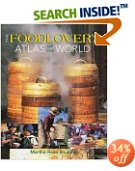The Foodlover's Atlas of the World

by Martha Rose Shulman
ISBN: 1552975711
Post Your Opinion | | A Review of: The FoodloverĘs Atlas Of The World
by Jon KalinaAsk anyone who knows me and they'll agree: I'm an incorrigible
know-it-all. I love to tell the story of how I won a free taxi ride
in Montreal from a Hungarian taxi driver who bet me the fare over
whether I knew the capital of Mongolia. "Ulan Bator," I
said promptly. He glowered. I glowed.
The thing is, it's hard work being a know-it-all which is why we
need books like Martha Rose Shulman's A Food Lover's Atlas of the
World. Therein lie many gems of food know-it-allism, such as the
fact that Scotland's "Auld Alliance" with France resulted
in the Scots using "jiggot"-from the French "gigot"-for
a leg of mutton and "ashet"-from the French word
"assiette"-to mean a meat dish. These are good tidbits
for table conversation, crossword puzzles and they may even help
you decipher a menu in Glasgow.
Shulman says she wrote the atlas to place food "in its
geographical context" and to answer a question most of us
haven't thought to ask: "what do places taste like, and
why?" This is not an easy question to answer and Shulman herself
admits that she's "barely scratched the surface." What
you do get is an over view of the world's major cuisines: what
people eat, when they eat it and what it might look like on a menu.
The book is divided into major areas-i.e. Europe, Africa and the
Middle East, Asia and Australasia and the Americas. These regions
are further sub-divided, not by countries but into regions of
culinary influence so that Britain and Ireland are together as are
Russia and Eastern Europe. Some cuisines may get short shrift here
(for example Poland goes virtually unmentioned) but the book covers
an impressive amount of ground and is hefty enough at three hundred
pages.
Shulman's particularly good on a favorite topic of mine which is
to trace some of the great migrations that foods have taken. Just
as there's no such thing as racial or linguistic purity there's no
such thing as culinary purity either. The most "traditional"
cuisines are really tangy mixtures of many different food cultures.
The Italians didn't have tomatoes until the Spanish brought them
to Europe from Mexico; nor did the Chinese or the Indians have
chilies until the Portuguese brought them. Likewise there was no
paprikas in Hungary, no peanuts in Africa and no potatoes in Ireland
until savvy Europeans introduced them.
In a rather nice passage Shulman writes about the circuitous food
routes that gave North African cuisine its distinctive range of
tastes. After centuries as a Roman province the Maghreb, as the
area is called, was conquered in the 8th century by Arabs who brought
with them a Persian-influenced cuisine. Eight centuries later
hundreds of thousands of Moors and Jews who were expelled by the
Catholic "Reconquista" of Spain came to the Maghreb,
bringing with them a rich Hispano-Muslim culinary tradition which
included such new flavors as potatoes, tomatoes and chilies.
And what about our own country? How does Canada fit into a foodlover's
atlas of the world? Unfortunately when Ms. Shulman comes to us she
seems to run out of things to say. Canada only rates two pages,
which in my darker moments I think might be just what we deserve,
although surely we've come a long way since the National Lampoon
gave this mordant recipe for Canadian food: "freeze and put
in a blander."
For instance, Shulman might have found something else to say of my
home province of Quebec other than we like our food spicier than
New Englanders, and that the black iron kettle is the focal point
of Quebecois cuisine (something that I dare say hasn't been the
case for a century). This last idea is in fact so wrong that it
casts doubts on the accuracy of the rest of the book.
I have a few other quibbles-sometimes her information is just too
obvious: are there any English speakers unaware that the British
like roast beef and Yorkshire pudding or that they drink tea?
A more important criticism is that any book calling itself an atlas
should have maps-something the book lacks utterly. If the publisher
wouldn't spring for even a single map they should have found a
different title.
That being said, the book is full of photographs, pleasantly written
and informative, and if you're lucky some nugget of information
might even earn you a free taxi ride.
|